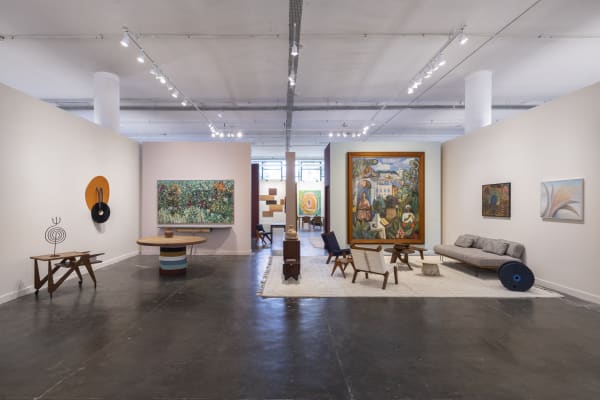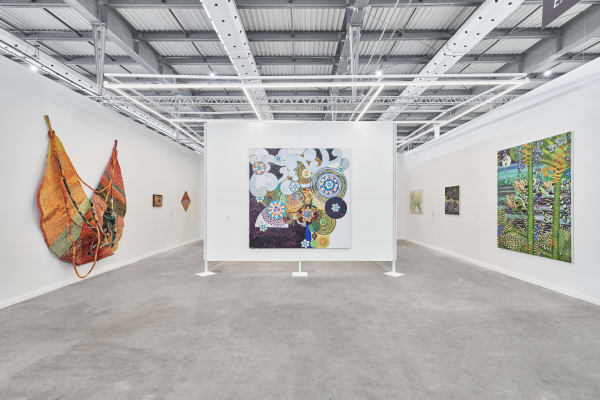Mucki Botkay b. 1958
Mucki Botkay (Rio de Janeiro, 1958) has always pursued color. After studying decorative arts at the École Supérieure des Ensembliers in Geneva in the late 1970s, she returned to Brazil and began exploring color initially in the fields of fashion and utilitarian design. She worked with various fashion designers and founded her own brand, but later decided to dive into creating artworks. Her work with textile printing evolved into compositions created through the dyeing and sewing of fabric cutouts on canvas. The introduction of embroidery into her work opened the door to experiments with beads, which led to the current stage of her production.
Curator Leonel Kaz describes Mucki’s current practice as painting, not with a brush, but with glass beads that are dyed according to the artist's own color palette. Inspired by the exuberant shapes and colors found in nature, she creates pieces that engage not only sight but also touch, through the movement and texture achieved by embroidering the beads.
The natural landscapes of the coastlines of Rio de Janeiro and Bahia, Mucki's second home for more than twenty years, are honored in her work. She brings to her paintings with beads the shapes and colors found in various ecosystems within the Atlantic Forest, such as mangroves, lagoons, and sandbanks. In creating compositions that sometimes echo masters of tapestry like Genaro de Carvalho and Roberto Burle Marx, Mucki not only reenacts nature but also stretches figuration, flirting with abstraction. In a sort of zoom-in effect, the artist focuses on the details of the landscape, refining it until the real suddenly becomes abstract. This deconstruction of nature into shapes and colors invites contemplation and the imagination of a living, abundant universe. For this reason, Mucki's works are like imaginary windows, the title of her first solo exhibition presented by Galatea in Salvador.
Through collaborations with embroiderers from the cities of Rio de Janeiro and Ilhéus, in Bahia, her works not only celebrate local culture and art but also empower a network of women in situations of social vulnerability by providing an additional source of income for their families. Thus, in addition to being a work filled with emotional memories that capture the cultural and natural richness of Brazil, it combines art with social impact, offering an opportunity for economic growth to talented women from vulnerable backgrounds.
-

Art Basel Miami Beach
Miami Beach Convention Center | Miami – EUA 5 - 7 Dec 2025Galatea and Isla Flotante are happy to participate in a joint presentation at Art Basel Miami Beach 2025 . Presented at booth F26 in the...Read more -

ArtRio 2025
10 - 14 Sep 2025Galatea is pleased to participate in the 15th edition of ArtRio , taking place from September 10th to 14th at Marina da Glória, in Rio...Read more -

SP-Arte 2025
2 - 6 Apr 2025Galatea is pleased to announce its participation at the SP–Arte 2025 fair, which will take place at the Bienal Pavilion, in Ibirapuera Park, from April...Read more -

ArtRio 2024
25 - 29 Sep 2024The Galatea booth at ArtRio 2024 presents a selection of works that reflects its artistic program. Showcasing a range of artists, from emerging talents on...Read more

![Mucki Botkay, Redemoinho [Whirl], 2022](/lib/archimedes/images/shim.gif)
